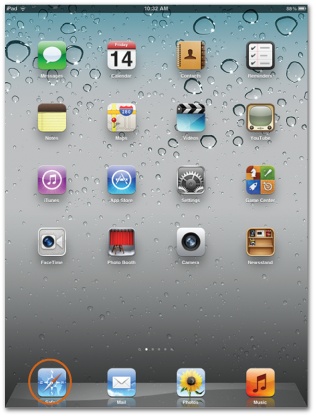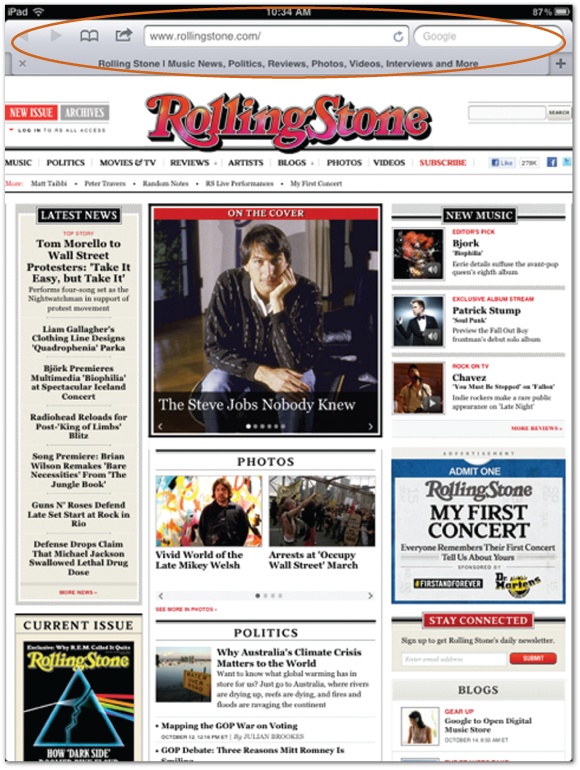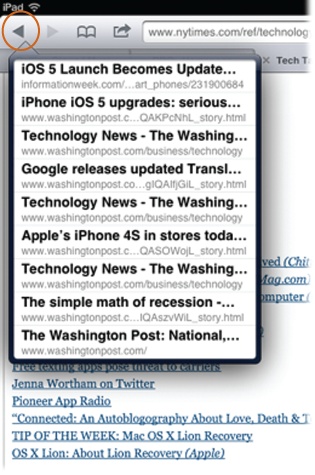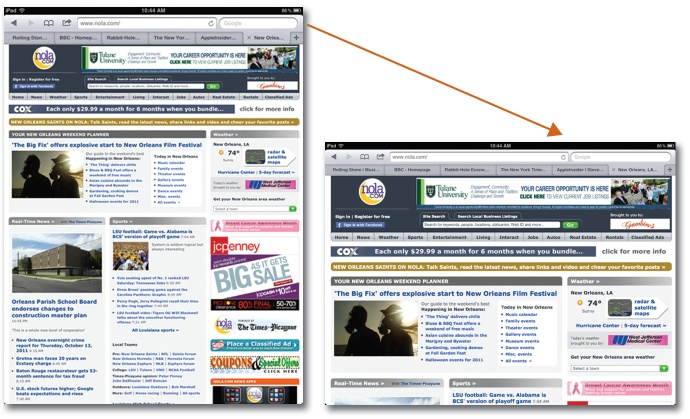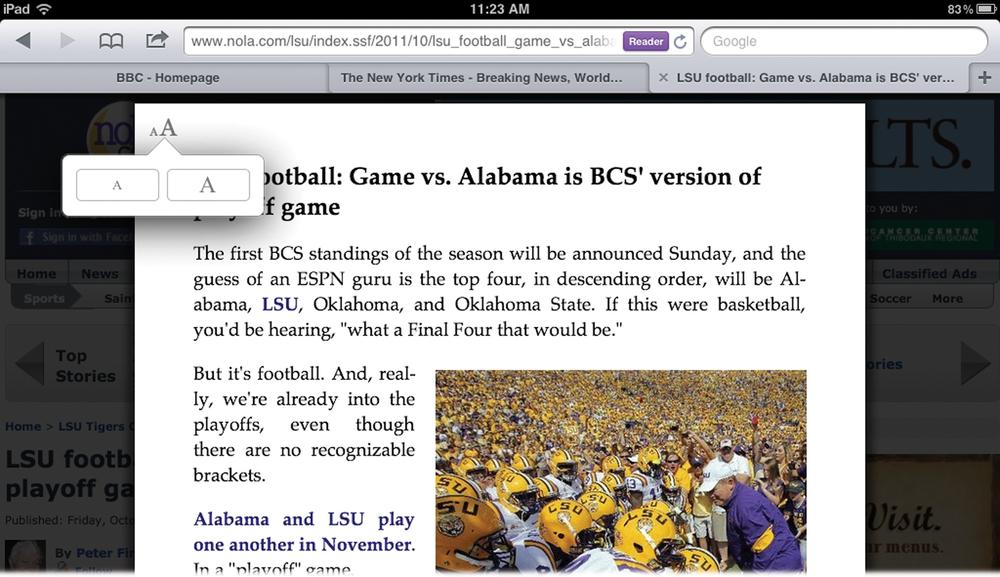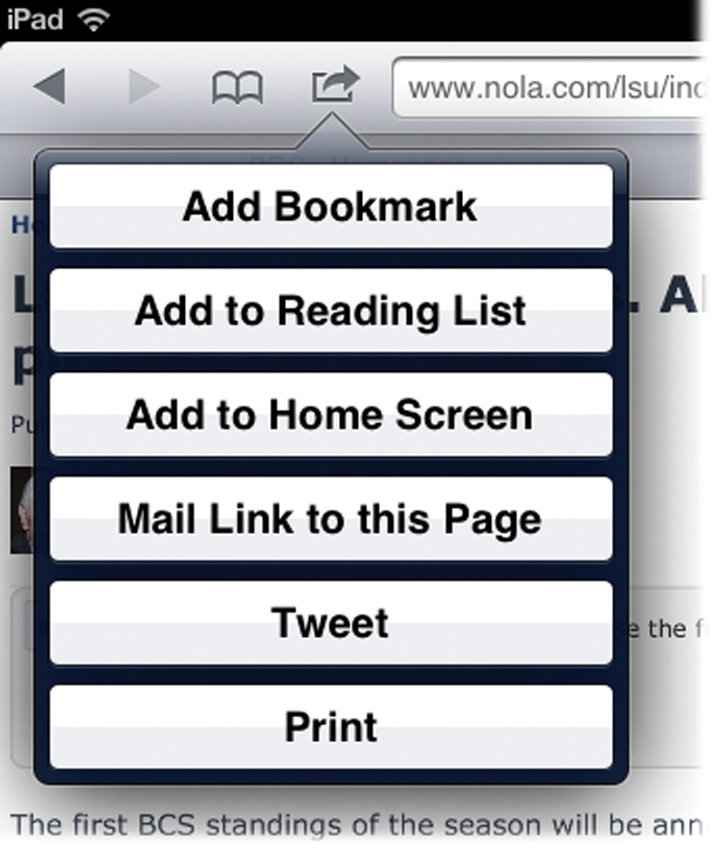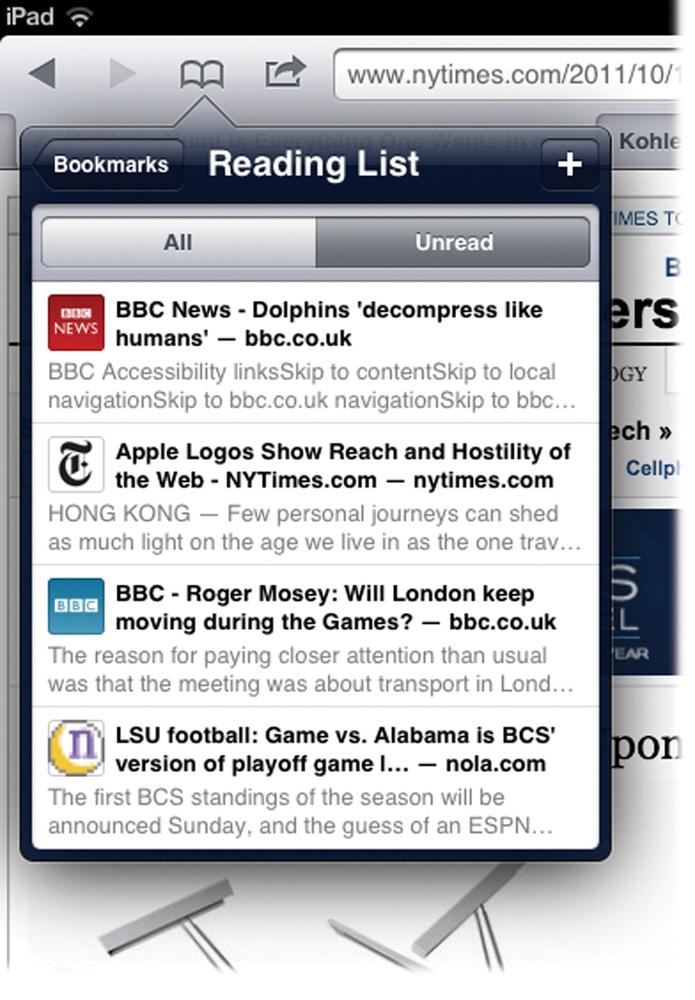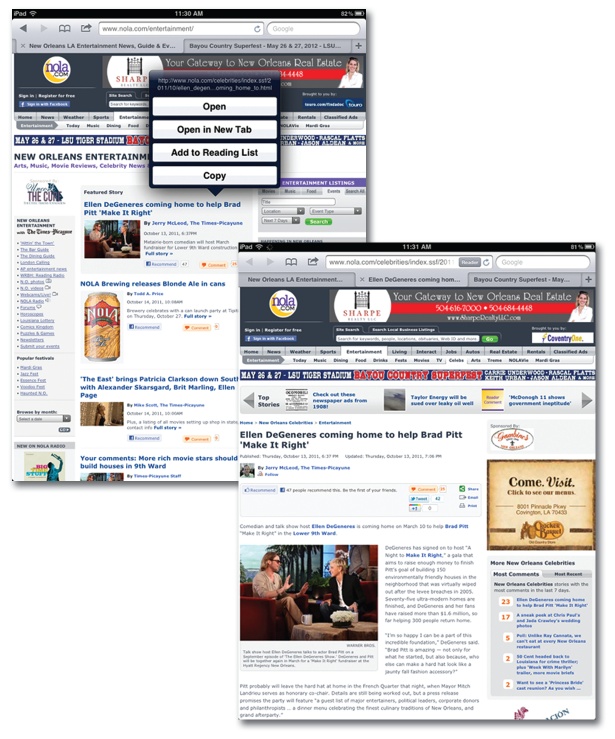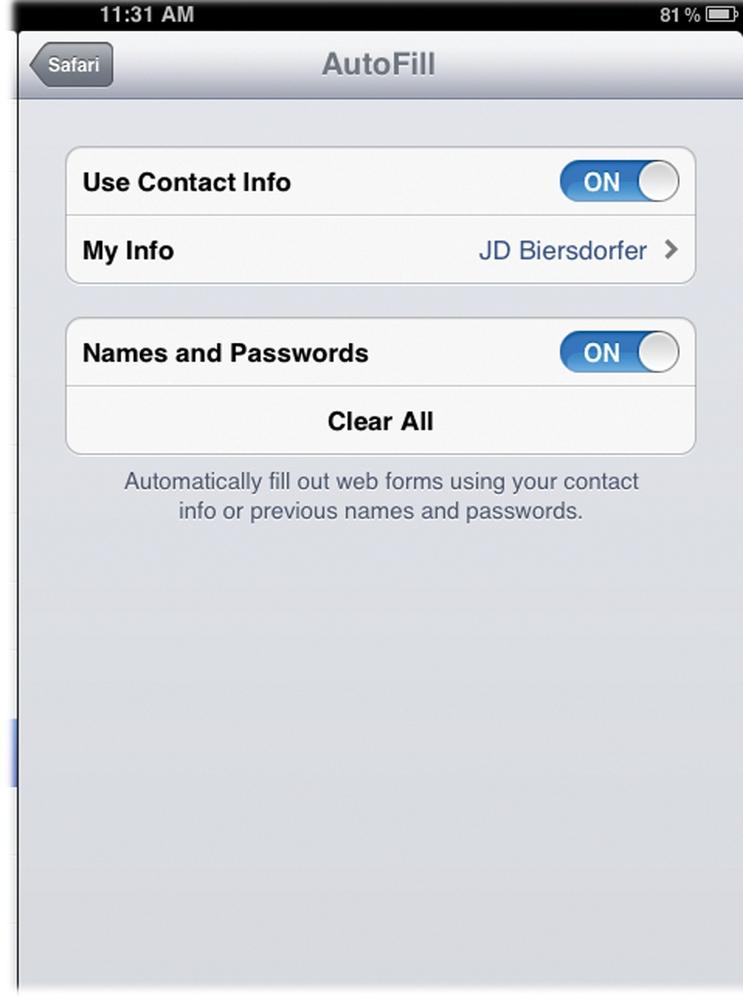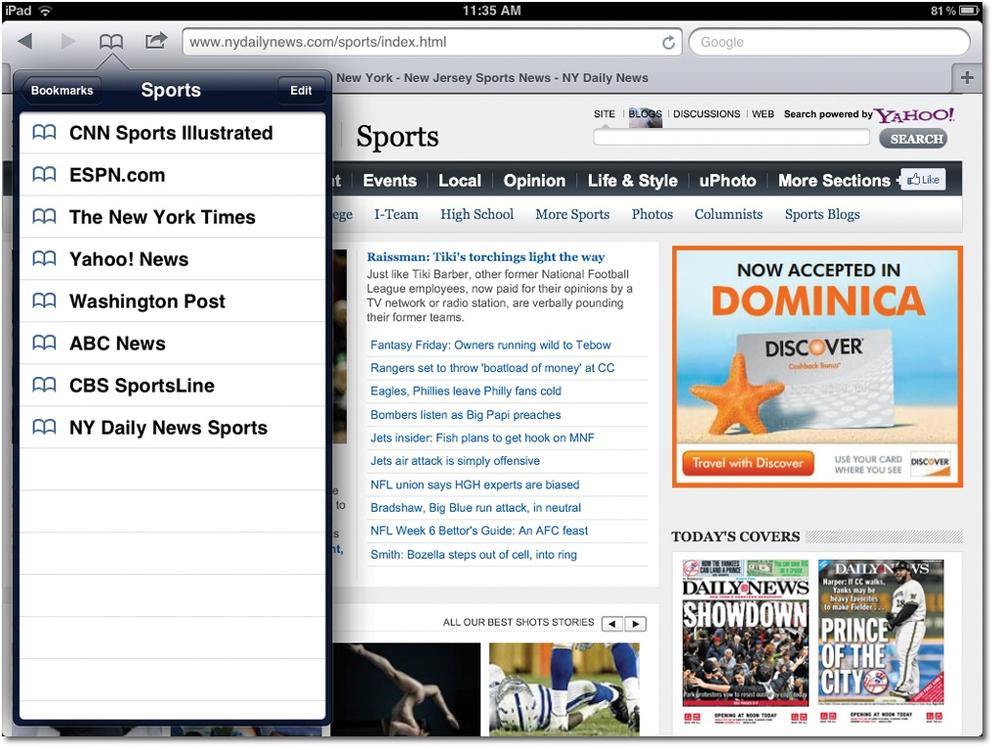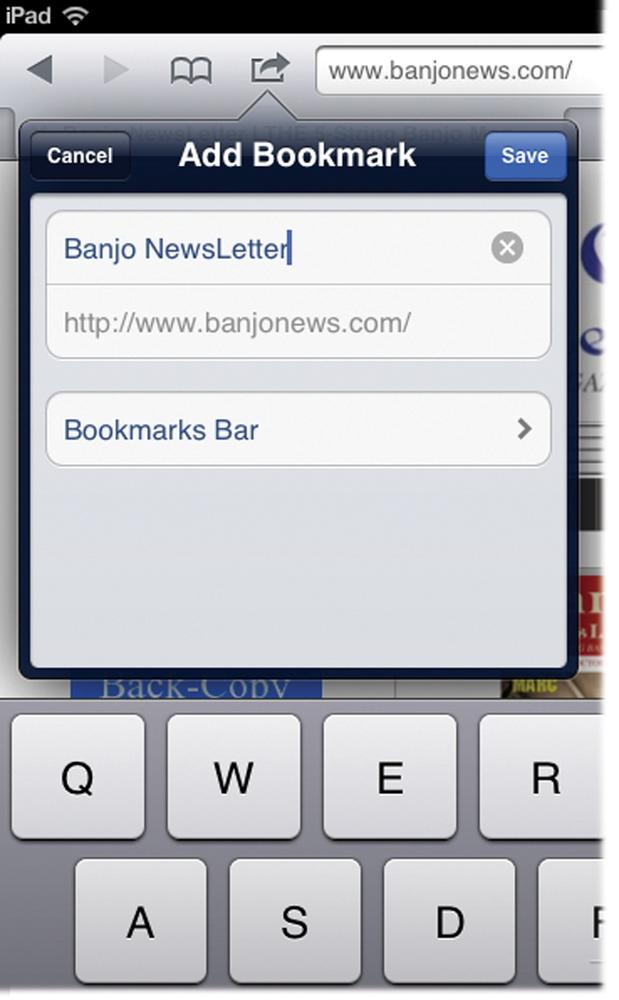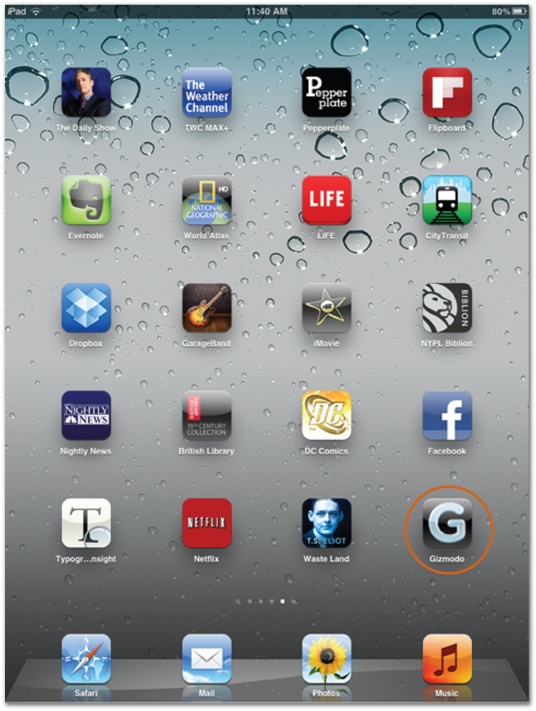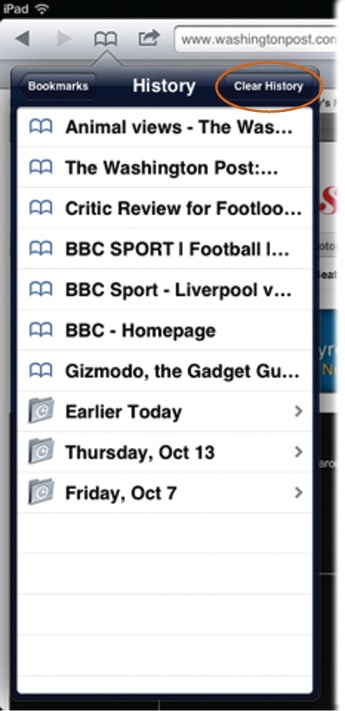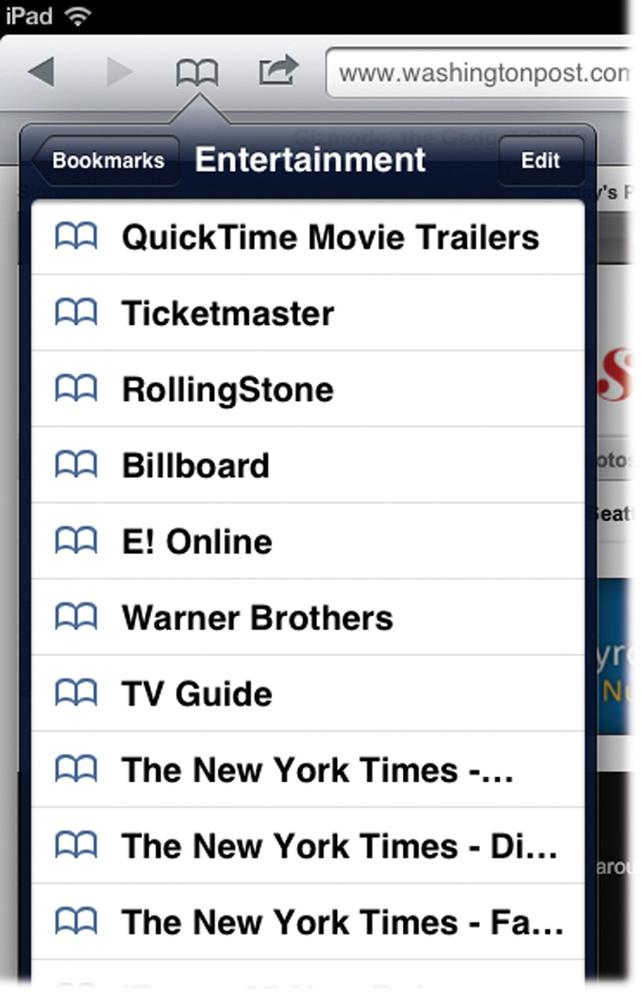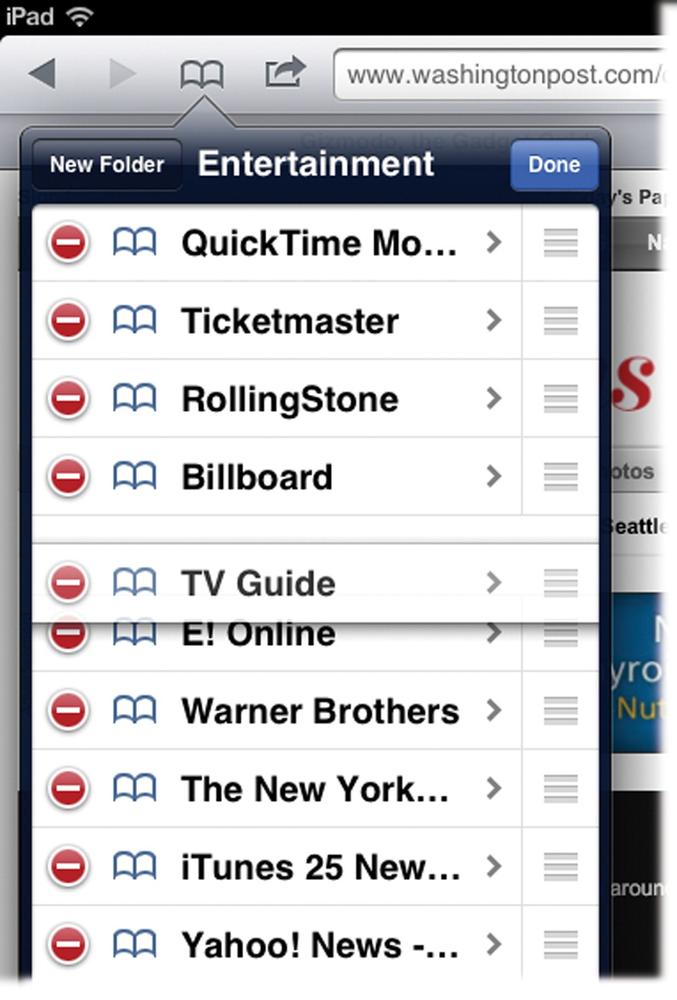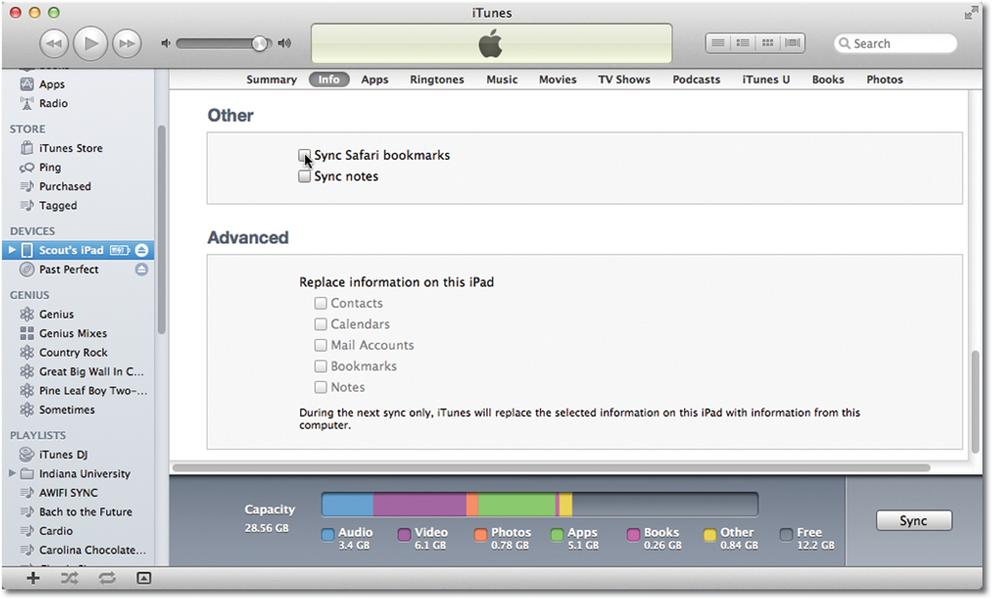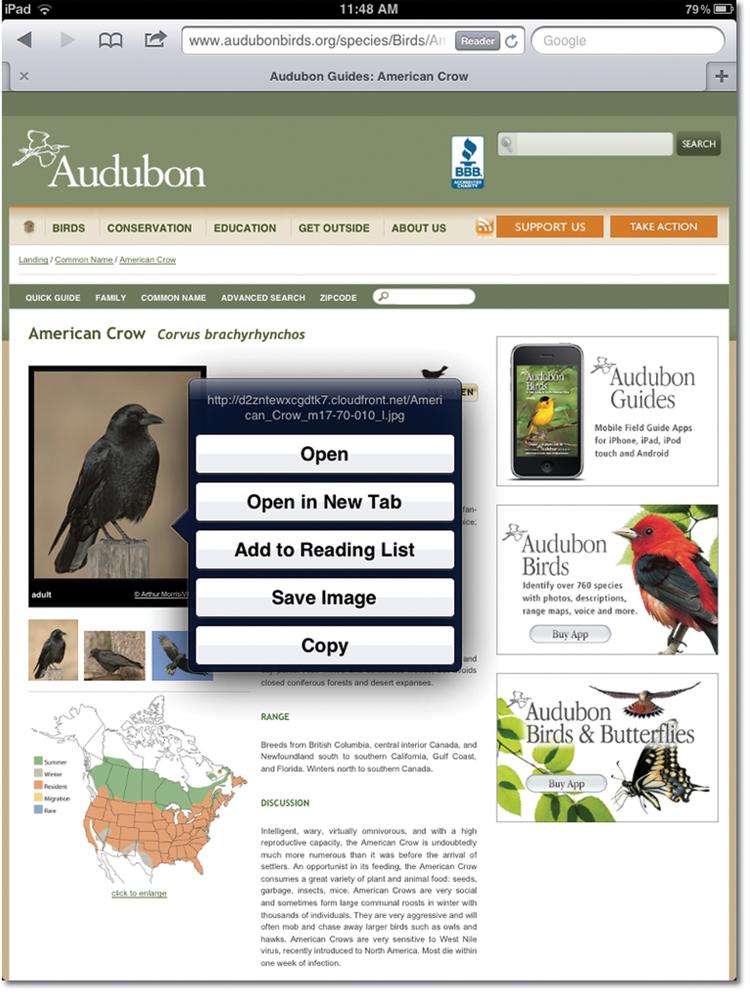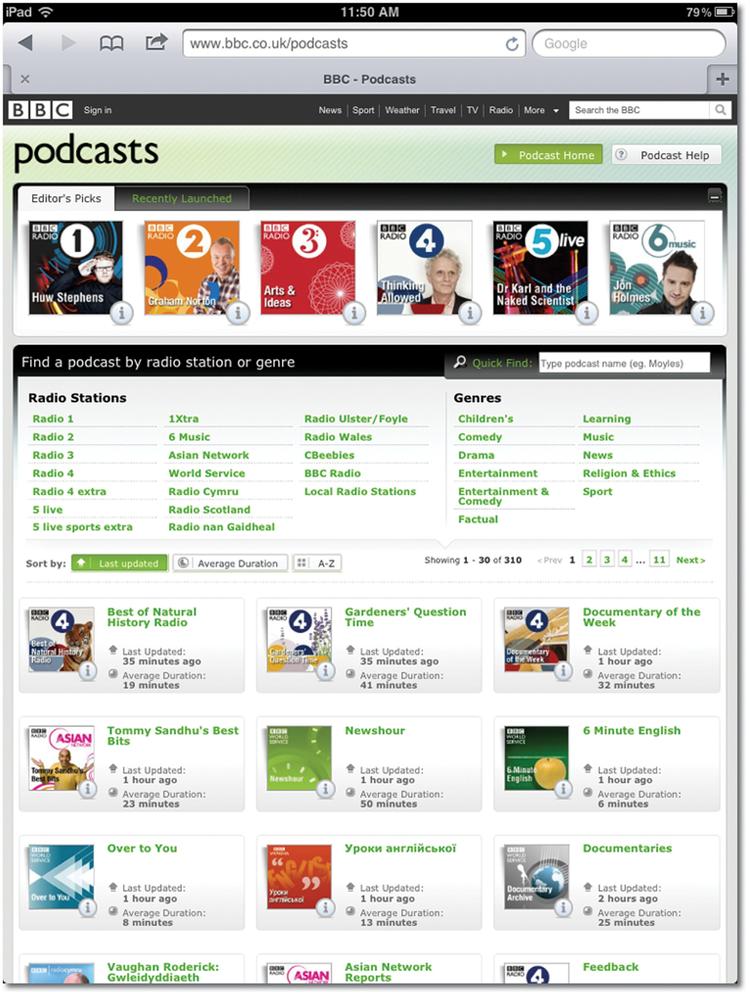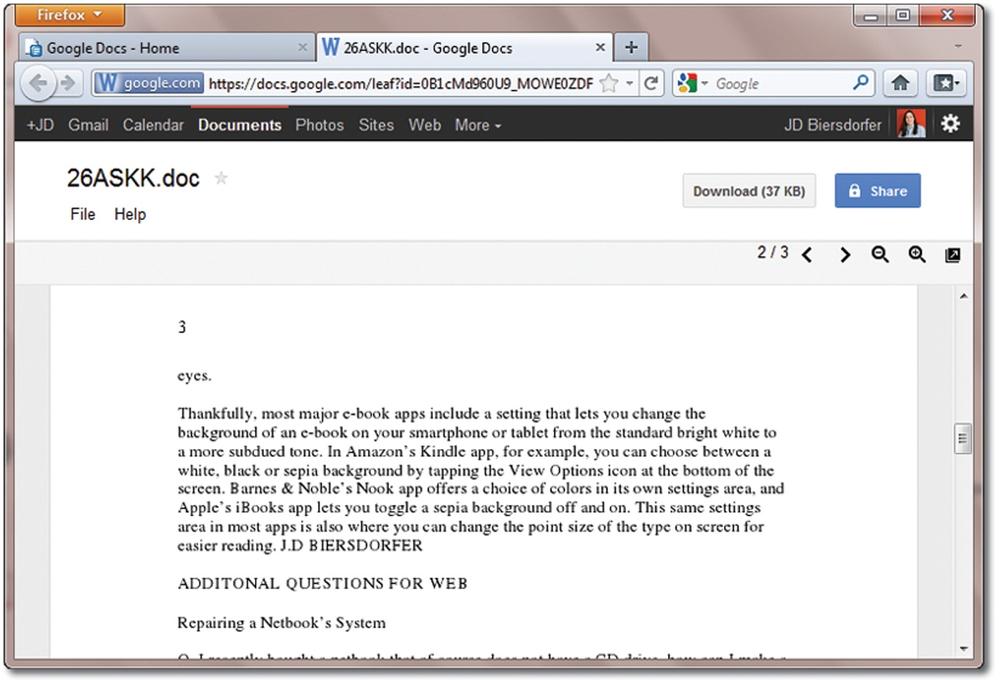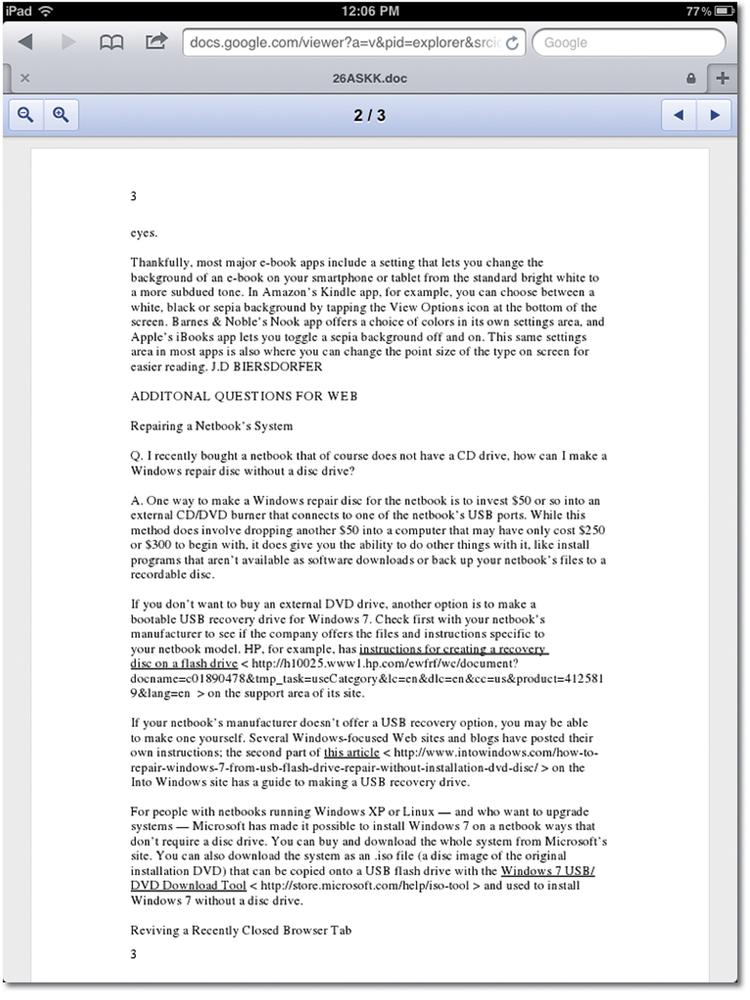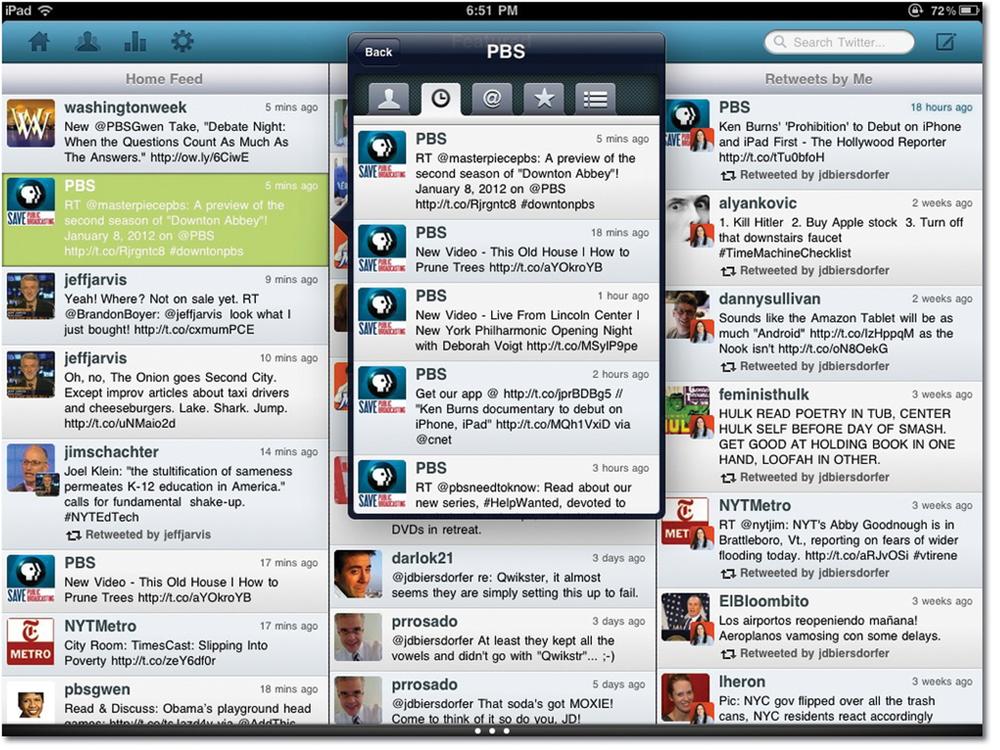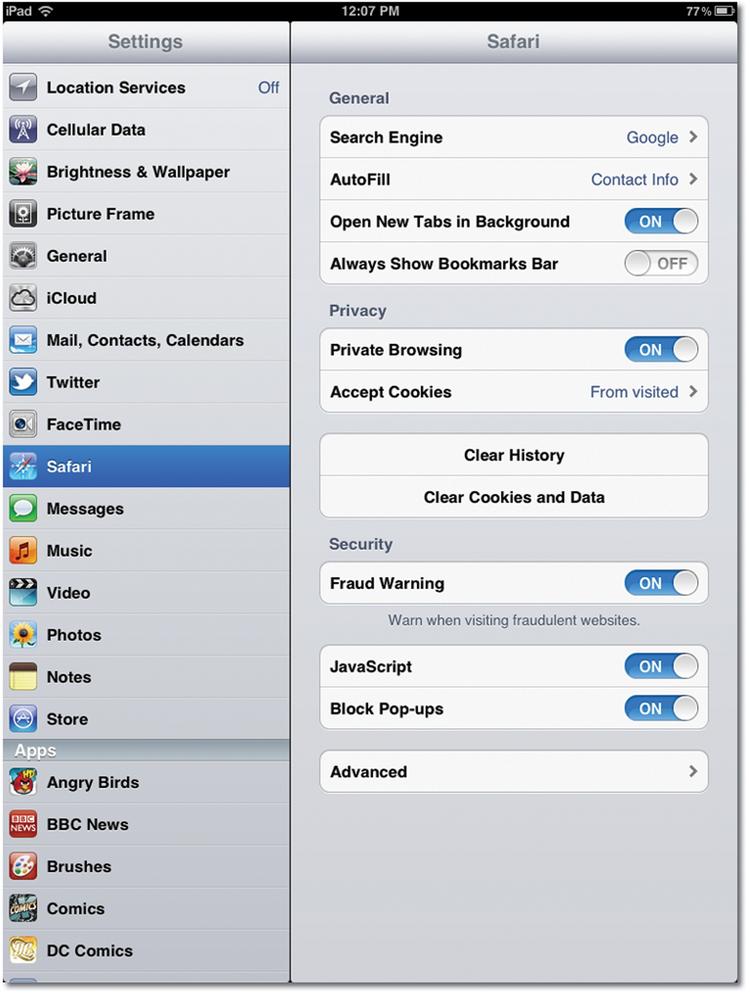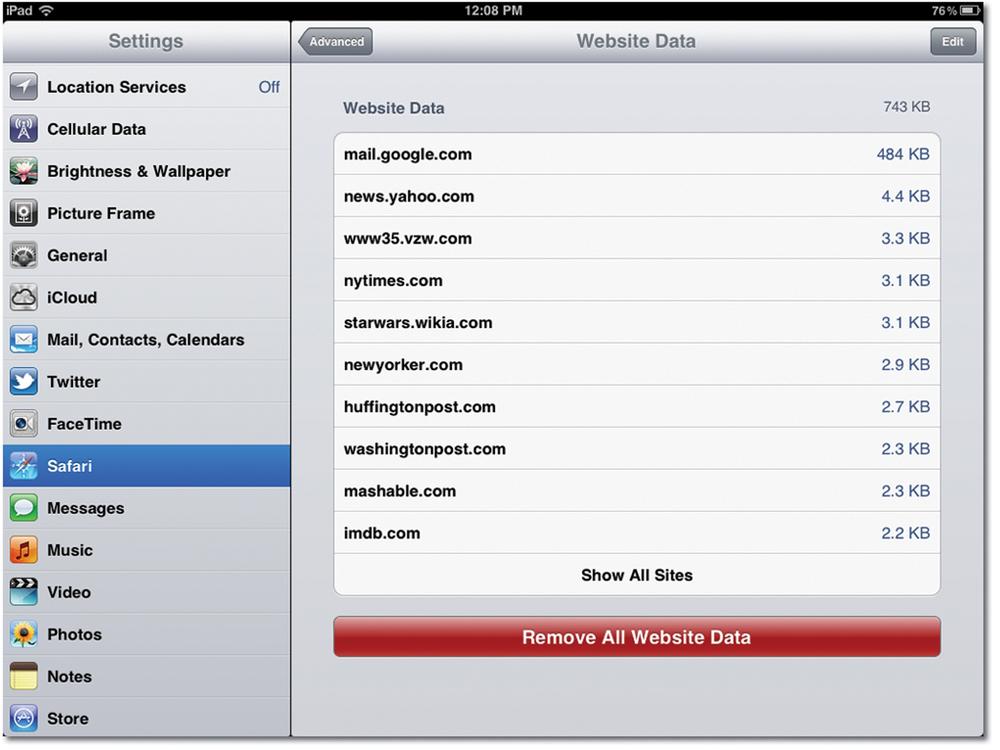Chapter 4. Surf the Web
Sure, you can surf the Web on a smartphone, but odds are you strain your neck and squint your eyes to read the tiny screen, even when you zoom in for a closer look. For most people, microbrowsing is fine on a train or waiting in line at the cineplex, but who wants to do that in a coffee shop, campus library, or on the couch?
Browsing the Web on an iPad eliminates the old strain ‘n’ squint. Its 10-inch screen shows you pretty much a whole web page at once. And forget mouse-clicking—the iPad uses a touch-sensitive version of Apple’s Safari browser, so your fingers do the walking around the Web. You jump from link to link with a tap, and zoom in on pages with a two-finger spread.
The latest version of mobile Safari, the one that arrived in October 2011, is the fastest and most versatile iOS browser yet. In iOS 5, Safari displays web pages more quickly than ever before—and brings tabbed browsing, clutter-free pages, and a save-it-to-read-later feature to the tablet.
From the basics of tablet-style browsing to tips on web security, this chapter gives you the grand tour of Safari on the iPad, your wide-open window to the World Wide Web.
Take a Safari Tour
The iPad makes it easy to get to the Web—just tap the Safari icon on your Home screen (circled). The first time you open the browser, you see an empty window, ready to host web pages. Tap the address bar so the iPad keyboard pops up and then type in a web address.
Except for the ability to play certain video files (those created with Adobe Flash), Safari has most of the features of a desktop browser: bookmarks, a History file, cookies, a pop-up blocker, and more.
When you go to a web page, ’Pad-Safari behaves just like a desktop browser, too. It highlights the address bar as it loads all the elements on a page and gives you Apple’s “Yo! I’m still loading the page!” animated icon at the top of the screen, which looks like this: ![]() .
.
Here’s a quick tour of Safari’s main screen, starting from the upper left:
 ,
,  (Back, Forward). To flip back to the page you were on before the current one, tap the
(Back, Forward). To flip back to the page you were on before the current one, tap the  button. You need to go back before you can go forward, so after you tap
button. You need to go back before you can go forward, so after you tap  , you can tap the
, you can tap the  button, which takes you to the page you were looking at before you tapped the
button, which takes you to the page you were looking at before you tapped the  button. Got it?
button. Got it? (Bookmarks). Tap here to see your list of favorite sites. (Flip ahead to Create and Use Bookmarks for info on working with bookmarks.)
(Bookmarks). Tap here to see your list of favorite sites. (Flip ahead to Create and Use Bookmarks for info on working with bookmarks.) (Action menu). Tap this multi-option icon to add a new bookmark, add the current page to your Reading List for later consumption (Use the Safari Reading List), add the page’s bookmark to your Home screen, mail a link to the page, share the link in a tweet from your Twitter account (Use Twitter), or print the page (if you have an iPad-friendly printer, as Print with Your iPad explains).
(Action menu). Tap this multi-option icon to add a new bookmark, add the current page to your Reading List for later consumption (Use the Safari Reading List), add the page’s bookmark to your Home screen, mail a link to the page, share the link in a tweet from your Twitter account (Use Twitter), or print the page (if you have an iPad-friendly printer, as Print with Your iPad explains).Address bar. This narrow white strip of typeable turf is where you enter a page’s web address (also known as its URL or Uniform Resource Locator) when you want to see the sites.
 ,
,  (Stop, Reload). If you request the wrong page or get tired of waiting for a slow-loading site, tap the
(Stop, Reload). If you request the wrong page or get tired of waiting for a slow-loading site, tap the  button on the address bar to stop the page from downloading any further.
button on the address bar to stop the page from downloading any further.If you don’t tap the
 button and the page loads normally, the
button and the page loads normally, the  button turns into a
button turns into a  button. Tap it to reload a page that doesn’t look right (say it’s missing a bunch of icons or graphics) or if you want to see the latest version of a site that updates frequently—like a news or auction site.
button. Tap it to reload a page that doesn’t look right (say it’s missing a bunch of icons or graphics) or if you want to see the latest version of a site that updates frequently—like a news or auction site.Search box. Safari has a separate little box for typing in search terms. Tap here and the keyboard pops up. Type in your keywords and tap the Search button that automatically replaces the Return key on your keyboard.
 (Add tab). Click the
(Add tab). Click the  to add a tab for a fresh new page—all without closing the page you’re on. Turn the page for more on tab-dancing.
to add a tab for a fresh new page—all without closing the page you’re on. Turn the page for more on tab-dancing.
Use Browser Tabs in Safari
The ability to open multiple web pages within the same browser window—and switch around between them—has been a standard feature on desktop-computer browsers for years. It’s also known as tabbed browsing, and as of iOS 5, it’s now a feature of the iPad’s Safari browser. (Browser tabs replace the old way of juggling multiple pages on the iPad, which involved tapping an icon to get to a screen of tiny web-page thumbnails that you could switch between, but it was kind of awkward to actually use.)
Using tabs on the iPad works just as it does on your laptop or desktop computer: You start with one page open in the middle of your browser. To open a second page without closing the first one, tap the ![]() icon beside the first tab and enter the address for the second site. When you add the new page, labeled tabs (circled) appear at the top of the Safari window.
icon beside the first tab and enter the address for the second site. When you add the new page, labeled tabs (circled) appear at the top of the Safari window.
For each new page you tap ![]() to open, a new tab appears. To switch between the open pages, just tap the page’s tab. To rearrange the tabs, drag them into a new order with your finger. You can have up to nine tabs open at once. Compared to the old method of handling multiple open pages, tabs are a quicker way to bounce back and forth between different web pages, especially if you’re doing research or comparing the content of two sites.
to open, a new tab appears. To switch between the open pages, just tap the page’s tab. To rearrange the tabs, drag them into a new order with your finger. You can have up to nine tabs open at once. Compared to the old method of handling multiple open pages, tabs are a quicker way to bounce back and forth between different web pages, especially if you’re doing research or comparing the content of two sites.
And when you look up and realize your browser has more tabs showing than the inside of a doctor’s filing cabinet, you can easily close unneeded tabs. Just tap the ![]() in the tab you want to close and it goes away.
in the tab you want to close and it goes away.
Can’t remember the name or address of a site you had open in a tab earlier in the day? You can jog your memory a couple of ways. For one, press down on the ![]() button (circled) to see a list of recently visited sites. For a list that goes back farther in time, check out your Safari History list (Call Up Your History List).
button (circled) to see a list of recently visited sites. For a list that goes back farther in time, check out your Safari History list (Call Up Your History List).
If you’re on a web page and see a link to a page that you want to open in its own tab, press and hold the link until the menu panel pops up (shown on Jump to Other Web Pages). Slide your finger down to the Open in New Tab option to pop open the page in its own tab.
While having tabs busting out all over your iPad screen is a great way to see the sites in a hurry, some people might prefer that Safari open pages in new tabs behind the scenes until they’re ready to look at them. If you find yourself in this camp, you can set Safari to do its page-popping behind the scenes. Just tap Home→Settings→Safari→Open New Tabs in Background→On.
Zoom and Scroll Through Web Pages
As soon as many new iPad owners unbox their tablets, they spend hours zooming and scrolling through web pages because it’s cool, fun, and novel to flick a finger across a piece of glass and see a web page respond.
Even though the iPad has a fairly large screen, it’s not quite the same experience as surfing the Web on your 17-inch laptop display or even bigger desktop monitor. Many companies offer mobile versions of their websites that bump up the size of text and graphics so you can see them better on iPads and smartphones. Better yet, many have free iPad apps that capitalize on the touchscreen for things like site navigation.
But not every site out there caters to iPad or smartphone users. You’ll encounter plenty of regular old web pages that look perfectly fine, except that they’re just a wee bit too small to read comfortably without some maneuvering:
Fortunately, the iPad gives you three ways to read pages more easily.
Rotate the iPad to Landscape Mode. Turn the tablet 90 degrees in either direction and the screen rotates and enlarges a web page to fill the wider side of the iPad.
Zoom and pinch. Place your thumb and forefinger (or whichever fingers you prefer) on the screen and slowly spread them apart to zoom in (enlarge) the part of the page between your fingers. To go in the opposite direction and reduce the size of the selected area, move your fingers closer together in a pinch formation.
Double-tap. Web pages are made up of different components (text, graphics, and so on), and Safari can isolate each one and magnify just that part. Find the section of a page you want to read and double-tap it with your finger to expand it. Double-tap again to reduce the section to its original size.
When you zoom in on a page and want to read a part that’s out of view, simply drag your finger on the glass to pull that section to the center of the screen.
You can also scroll around a page quickly by flicking your finger across the glass. As your finger flies around, you may inadvertently hit a link, but Safari knows that you’re in transit and doesn’t open the linked page or site. To actually click a link, stop scrolling and tap the link with your finger.
Tip
Every so often, you’ll find, on certain web pages, a frame (a column of text) with its own scroll bar—an area of content that scrolls independently of the main page. (If you have a Facebook account, the Friends list is such a frame.) The iPad offers its own way to navigate one of these frames without scrolling the whole page: It’s the two-finger drag. To scroll within a frame, use two fingers instead of the usual one.
Use Safari Reader
You know how some web pages contain a really fascinating article you want to read—but the page itself is surrounded by so many advertisements, graphics, toolbars, and other pixel detritus that you feel like you’re in the middle of a carnival midway? (And don’t you hate that?)
The good news is that iOS 5 has a wonderful feature called Safari Reader. Like its cousin-in-code for the desktop, Safari Reader strips away all the distracting and nonessential graphics and other elements on a page, and presents that article in a nice, easy-to-read format. It’s like a pair of comfy slippers for your eyes.
The bad news? Not every website works with Safari Reader. In fact, some website operators hate browsers (and browser add-ons) that strip out ads from their web pages because they make money from those ads. But there are still plenty of sites that work well with the Reader.
To tell if a web page supports Safari Reader, look up in the address bar for a  icon. If you see one, tap it. Like magic, the icon turns purple (shown below), the distracting ads melt away, and only the essential text and images appear front-and-center on the page. You can even adjust the font size within the Reader version of the page by tapping the
icon. If you see one, tap it. Like magic, the icon turns purple (shown below), the distracting ads melt away, and only the essential text and images appear front-and-center on the page. You can even adjust the font size within the Reader version of the page by tapping the ![]() icon until you’re satisfied with the way things look.
icon until you’re satisfied with the way things look.
Not only can you now read in comfort, but you can share the page in this form by tapping the ![]() icon on the Safari toolbar and choosing to email it, print it, tweet it to pals, bookmark it, or add it to your Reading List (next page). And when you’re done reading with Reader, just tap the
icon on the Safari toolbar and choosing to email it, print it, tweet it to pals, bookmark it, or add it to your Reading List (next page). And when you’re done reading with Reader, just tap the  button again to return the page to its normal, hot-mess form.
button again to return the page to its normal, hot-mess form.
Use the Safari Reading List
Find a lot of great stuff on the Web, but no time to read any of it? That’s where Safari’s Reading List feature can help. While it can’t actually add a few hours to your day, it can save links to those articles you find during your surfing travels and have them waiting for you when you do have time to read. The Reading List is like a special, temporary Bookmarks list that knows what you’ve read.
The next time you’re browsing around in Safari and find an article that you just don’t have time to fully explore, tap the ![]() icon and choose Add to Reading List from the menu (shown at right). That article is now saved to your personal reading list within the browser. Repeat this process with any article you want to save for later reading.
icon and choose Add to Reading List from the menu (shown at right). That article is now saved to your personal reading list within the browser. Repeat this process with any article you want to save for later reading.
Later, when you have time to read all the pages you saved, tap the ![]() icon and choose Reading List from the menu. Now you can see a tidy list of all your saved articles. To read one, tap its entry. (When you the Reading List panel is visible, you can add the current page to the list by tapping the
icon and choose Reading List from the menu. Now you can see a tidy list of all your saved articles. To read one, tap its entry. (When you the Reading List panel is visible, you can add the current page to the list by tapping the ![]() icon in the top-right corner.)
icon in the top-right corner.)
Safari divides the Reading List into two parts, All and Unread. All, as you may have guessed, shows every article you’ve added to the list. The Unread list shows just the stories you haven’t tapped open and browsed yet. As you open, read, and move on with each saved article, the link for it automatically moves from the Unread list to the All list—saving you the trouble of remembering what you have and haven’t read.
To permanently remove a story from the Reading List, swipe your finger along the entry and tap the red Delete button.
If you find yourself reading stories on your computer, iPad, or other iOS 5 device, like an iPhone, the Reading List gets even cooler if you use iCloud (Chapter 16). That’s because iCloud syncs your Reading List among all your devices, so stories you save in one place, say your iPhone, will show up on your iPad and desktop or laptop computer as long as all the devices use the same Apple ID (Set Up an Apple ID). Just tap Home→Settings→iCloud and tap Bookmarks to On.
Jump to Other Web Pages
You may find yourself so mesmerized by navigating the iPad with a series of finger moves that you completely forget about the concept of clicking links, especially since you’ve probably use a computer mouse to do that for the past 15 years or so.
Here’s how you handle links on the iPad: Tap them with your finger, much the way you’d click them if you did have a mouse. As you know from desktop-computer browsing, not all links are blue and underlined. Some, in fact, are graphics, like pictures or icons.
Tip
If you hold your finger on a link for a moment—press it rather than tap it—a box pops up identifying the link’s full web address and offering four buttons: You can open the linked page, open it in a new browser tab, add the story to your Reading List (Use the Safari Reading List), or copy the link to the iPad’s clipboard to paste it elsewhere. Cut, Copy, Paste, and Replace Text shows you how to copy and paste text.
Use Autofill to Save Time
Some people will love the iPad’s simple virtual keyboard, and some will hate it because it feels like typing on a glass coffee table. And some will use it only when buying things online while relaxing in the hammock out back. No matter how you feel about the keyboard, there’s one feature built into Safari that’s bound to please everybody: Autofill.
Autofill, as its name suggests, automatically fills in your name, address, and phone number on web forms—saving you the drudgery of typing in the same information all the time. It’s convenient, reduces your keyboard time, and speeds up purchases for power shoppers.
Along with your contact info, Autofill can remember passwords for websites that require them, but be careful with this. If you accidentally lose your iPad or someone steals it, the thief can retrieve your password, waltz right into your password-protected accounts, and steal even more from you.
To turn on Autofill, start on the iPad’s Home screen and tap Settings → Safari → Autofill. On the Autofill screen, tap the On button next to Use Contact Info. Tap the My Info line below it and choose your own name and address from your Contacts list. (See Maintain Contacts if you don’t have a contact file for yourself.) Now when you come to a web form that wants your info, you’ll see an Autofill button on the iPad keyboard; tap it instead of doing all that typing.
If you want to go ahead and use the password-supplying part of Autofill, tap the button on the Settings screen to On. Now, whenever you hit a site that requires your password, Safari gives you three choices: Yes, Never for this Website, and Not Now (the latter means you’ll get pestered again on your next visit). Say Yes and the browser logs you into the site automatically from then on.
To play it safe, say Yes only to non-money-related sites, like online newspapers. Tap “Never for this Website” for any bank, stock-trading, e-commerce, or other site that involves money and credit-card numbers.
Create and Use Bookmarks
Did you configure your iPad’s syncing preferences to grab bookmarks when you first set up the tablet? If so, you’ll find Safari already stuffed with bookmarks (Favorites)—that is, a list of sites you can re-visit with just a tap on the screen, so you don’t have to remember and type in their URLs.
If you ripped your iPad out of its box as soon as you got it and haven’t yet introduced it to your Windows PC or Mac (or signed up for iCloud), you can easily copy your existing desktop browser’s bookmarks from Internet Explorer (Windows) or Safari (Macintosh and Windows; Sync Info has instructions).
To see all your bookmarks, tap the ![]() button at the top of the screen. The Bookmarks box appears. Some bookmarks may be floating loose in the list, while others are neatly filed in folders, or even folders within folders. Tap a folder to see what’s inside. Tap a bookmark to open the website it points to.
button at the top of the screen. The Bookmarks box appears. Some bookmarks may be floating loose in the list, while others are neatly filed in folders, or even folders within folders. Tap a folder to see what’s inside. Tap a bookmark to open the website it points to.
Tip
The handy search box at the top-right of the Safari window can do more than sniff around the Web for your search terms. When you tap in a keyword, it also shows you how many times the word appears in the current web page, which is really helpful if you’re wading through several screens’ worth of text—if the current page has no hits, move on. In iOS 5, searching within a page is even better—a Find on Page search box sits on top of the keyboard, ready to highlight the elusive word in context.
Add New Bookmarks on the iPad
As you surf, you can add new bookmarks right on your iPad. And any sites you bookmark there get copied back to your computer the next time you sync up.
To add a cool new site to your Bookmarks list, tap the ![]() icon at the top of the screen and then tap Add Bookmark. On the Add Bookmark screen, you have these choices:
icon at the top of the screen and then tap Add Bookmark. On the Add Bookmark screen, you have these choices:
Rename it. Some websites have hideously long names, like “Uncle Earl’s Good-Time Five-String Finger-Pickin’ Jam Session,” but you can change that. Tap the top box on the Add Bookmark screen and rename the site something shorter, like “Banjos.”
The box right below that—which you can’t mess with—displays the site’s official web address.
File it. The third line down in the Add Bookmark box lets you file the bookmark in a folder (see Edit and Organize Bookmarks and Folders) or add it to the Bookmarks bar in the browser window for quick ‘n’ easy access. Tap the Bookmarks link to open Safari’s list of bookmark folders. When you find the one you want, tap the folder’s name to deposit your bookmark there, where it awaits your return the next time you want to visit that site.
Tip
If you make a mistake as you tap in a URL and don’t notice it right away, you don’t have to backspace all the way to the typo. Press your finger down on the text until a magnifying glass and a flashing insertion cursor appear, then drag your finger to the error, lift your finger, and correct the mistake. Then go back to where you were.
Make Home Screen Bookmarks
Are you one of those people who has shortcuts to your absolute favorite websites right on your computer’s desktop? If so, you probably want to continue the tradition on your iPad’s Home screen. Not a problem.
When you’re on a site you want to save, tap the ![]() button at the top of Safari and choose Add to Home Screen from the menu box. The site’s icon now sits on your iPad’s main screen. And don’t worry about filling up your Home screen pages—you can have up to 11 of ’em and flick among them—or, if you run out of Home screen real estate, you can consolidate icons by storing them in a folder. See Make Home Screen App Folders for instructions.
button at the top of Safari and choose Add to Home Screen from the menu box. The site’s icon now sits on your iPad’s main screen. And don’t worry about filling up your Home screen pages—you can have up to 11 of ’em and flick among them—or, if you run out of Home screen real estate, you can consolidate icons by storing them in a folder. See Make Home Screen App Folders for instructions.
Call Up Your History List
The iPad’s Bookmarks menu (![]() ) holds other important surfing tools besides your collection of favorite sites and the Reading List web pages you’ll get around to reading one day. This menu is also where you go to look up your browsing history.
) holds other important surfing tools besides your collection of favorite sites and the Reading List web pages you’ll get around to reading one day. This menu is also where you go to look up your browsing history.
The History button on desktop browsers has saved many a soul who can’t remember the name of that really informative site from the other day. Safari on the iPad doesn’t let you forget your history, either (well, not without some extra work—see Use Safari Security), and it, too, quietly keeps a list of the sites you recently surfed.
To see your web trail, tap the ![]() button and then tap the History folder, where Safari stores your past sites in tidy subfolders with names like “Earlier Today.” Tap a bookmark within one of the History subfolders to go back in time—or at least back to that site. The link won’t be in the History folder forever (time does march on, and so does the History list), so you may want to bookmark it for real within the week before it slips away.
button and then tap the History folder, where Safari stores your past sites in tidy subfolders with names like “Earlier Today.” Tap a bookmark within one of the History subfolders to go back in time—or at least back to that site. The link won’t be in the History folder forever (time does march on, and so does the History list), so you may want to bookmark it for real within the week before it slips away.
Erase the History List
Don’t want to leave a record of your browsing history in case someone picks up your iPad and snoops around? One way to prevent that is to set up a Passcode Lock on your iPad, as described on General. Then, anyone who wants to get into your iPad needs a four-digit code to unlock the screen.
Another way to clean up after yourself is to erase your whole History list. To do that, open the History folder and tap the Clear History button in the top-right corner (circled above). You’ve just wiped away your personal History. Many politicians probably envy you.
Edit and Organize Bookmarks and Folders
Safari lists bookmarks in the order in which you save them, and that may not be the easiest way to remember where they are—especially if you wander around the Web saving site addresses every day. But iPad Safari is ready for this inevitability, as well as the probability that you’d like to delete old bookmarks every once in a while.
Editing your bookmarks—and folders of bookmarks—is quick and efficient on the iPad’s version of Safari. To edit a bookmark or folder, tap the ![]() button and then tap the Edit button. To edit bookmarks inside a folder, tap the
button and then tap the Edit button. To edit bookmarks inside a folder, tap the ![]() button, tap open the target folder, and then tap the Edit button.
button, tap open the target folder, and then tap the Edit button.
Tip
If you’re a newshound, there’s one thing worth bookmarking: the RSS feed of your favorite news site—or all the RSS feeds from all your top sites. RSS feeds are subscriptions to a site’s story summaries (the abbreviation stands for Really Simple Syndication). Subscribe, and you spare yourself the tediousness of checking sites for updated news and information manually, plus you get to read short summaries of new articles without ads and blinking animations. If you want to read a full article, just tap its headline.
Safari doubles as a handy RSS reader. Whenever you tap an “RSS Feed” link on a web page, or whenever you type the address of an RSS feed into the Address bar (it often begins with feed://), Safari automatically displays a handy table-of-contents view that lists all the news blurbs on that page right in the browser.
Here’s what you can do to bookmarks and folders after you tap Edit:
Delete them. When it’s time for that bookmark or folder to go, tap the
 button and then tap the Delete button to confirm. (You can’t delete the History folder, however.)
button and then tap the Delete button to confirm. (You can’t delete the History folder, however.)Edit them. Need to rename a folder or bookmark? Tap a folder to get to the Edit Folder screen so you can change the folder’s name. To edit a bookmark, tap it to get to the Edit Bookmark screen, where you can change its name and address. Tap the Bookmarks button in the upper-left corner when you’re done.
Refile them. To make a new folder, tap the New Folder button in the upper-left corner of the Edit screen, then name it and tap Bookmarks to specify where you want to file it. You can move an existing folder by tapping it, choosing a new location on the Edit Folder screen, and relocating the folder elsewhere in the Bookmarks list.
Rearrange them. Need a new order for your bookmarks or folders? As shown below, drag the three-bar grip strip (
 ) up or down the list to move folders or bookmarks to a new place. (You can’t move the History folder, however.)
) up or down the list to move folders or bookmarks to a new place. (You can’t move the History folder, however.)
Sync Your Bookmarks
Saving bookmarks on the iPad as you go is fine, but over the years, you’ve probably built up a considerable collection of bookmarks on your desktop computer as well. In fact, you’re probably very attached to some of those links. The good news is, you can take them with you—at least on the iPad.
To copy your entire Internet Explorer or Safari bookmark library from your computer to your iPad, all you need to do is turn on a checkbox in iTunes. (Mozilla Firefox fans can sync up with apps like Firefox Home or Sync Browser.) Connect your iPad (either by USB cable or Wi-Fi Sync), click its icon in the iTunes window, and then click the Info button at the top of the screen. Scroll down past things you can sync, like contacts, calendars, and mail accounts, until you get to the section called Other. Now, do the following, depending on the type of computer you have:
Windows PCs: Turn on “Sync bookmarks with:” and then choose either Safari or Internet Explorer from the menu. Click Apply, and then click Sync.
Macs: Turn on “Sync Safari bookmarks,” click Apply, and then click Sync.
As mentioned on the previous page, bookmarks you make on the iPad get synced back to your computer. But if things start to get too discombobulated and you decide you want to wipe out all the bookmarks on your iPad and start over with a fresh set from your computer, scroll down to the Advanced area of the Info screen (where it says “Replace information on this iPad”). Then put a check in the box next to Bookmarks before you sync again.
This is the iTunes way to sync. If you have one of Apple’s free iCloud accounts, you can sync bookmarks on all your devices over the air, as Set Up iCloud on Your iPad explains.
Save and Mail Images from the Web
Every once in a while, you come across an image on a web page that you just have to have on your computer. It could be a cool photo of your favorite ball player, an image of a house on a real-estate site, or a wacky picture of a disgruntled Pekinese. Now, on a desktop system, you just have to right-click (Control-click) the image with your mouse and choose “Save Image to Desktop.” But how do you do that on the iPad, where there’s no mouse, trackpad, or obvious way to right-click on anything?
Easy. Press the desired photo or graphic with your finger. A box pops up with a whole bunch of options, like Open, Open in New Tab, Add (the page) to Reading List, Save Image, and Copy. Tap the Save Image button to download a copy of the picture to your iPad’s Photo library (Find Pictures on Your iPad). From there, you can look at it any time you want, or email it to someone (Share and Print Photos).
Stream Web Audio and Video
When the iPad was announced in 2010, there was much grumbling about the fact that it wouldn’t play files in the Adobe Flash format—which is a large portion of the videos and browser-based video games on the Web. In fact, some people thought the lack of Flash support would deal a crippling blow to the iPad’s chances of success.
But guess what? Those naysayers were wrong. Sure, the iPad doesn’t recognize Flash, RealPlayer, or Windows Media file formats, but it can do a fair amount of streaming in other formats. After all, it has that whole YouTube app (Watch YouTube Clips) that plays plenty of videos, and it plays QuickTime movies, like movie trailers, so long as they’ve been prepared in iPad-friendly video formats (Video Formats That Work on the iPad). It also plays MP3 and WAV audio files right off the Web. Here are a few sites to sample:
BBC News. The Beeb’s podcasts stream nicely, and you can search shows by radio station, genre, or get an A to Zed list; the company also has a fine iPad app (described on Use Newspaper and Magazine Apps; www.bbc.co.uk/podcasts/).
“Meet the Press” audio stream. You can find an MP3 edition of the venerable Sunday-morning talk show here: http://podcast.msnbc.com/audio/podcast/MSNBC-MTP.xml.
National Public Radio. NPR has many of its signature programs, like “All Things Considered” and “World Café,” along with “Morning Edition” and other newscasts, online and ready to stream through your iPad’s speaker at m.npr.org. (NPR has a news-focused iPad app in the App Store, too.)
New York Times podcasts. Check out a whole page of news shows that start streaming when you tap the MP3 link (www.nytimes.com/podcasts; the author is an employee of the New York Times).
Just about any MP3 file plays perfectly fine in the Safari browser. If you’ve already exhausted your iPad’s music library, search for free mp3 music or check your favorite radio station’s website for an MP3 stream of its live broadcast.
As for video, you have more to watch on the Web than just ’Pad-friendly streaming videos at Home→YouTube (Watch YouTube Clips). And Apple hosts a huge collection of movie trailers at trailers.apple.com and through the free iTunes Movie Trailers app. With either, tap a movie poster to get started.
Work with Online Apps
With the rise of mobile Internet-connected devices came the increased popularity of cloud computing—using programs that reside and store files online, up in the clouds, where you can get to them from any Web-enabled machine. This means you don’t have to drag around a seven-pound laptop stuffed with business software just to update a spreadsheet, because you can edit it online with a two-pound netbook. Or an iPad. And not just with iCloud (Chapter 16).
Not every cloud-computing site works with the iPad—Adobe’s Flash-based Photoshop.com site, which lets you edit pictures online, is one example. Other sites may have limited functionality, like the ability to read files but not edit them. Still, if you need to quickly look up something in a document stored online or check the status of an ongoing project, point your iPad toward the cloud.
Google Docs is probably one of the most popular cloud-based suite of apps, partly because it’s free, partly because it can handle Microsoft Office documents, and partly because it belongs to the ever-growing Google Empire of Free Programs. To use it, you need a Gmail or Google account (also free at www.google.com). Once you sign up, you can create, edit, and share files right in your computer’s web browser—including word-processing documents, spreadsheets, and basic presentations.
Since all those files are online, you can get to them through the Safari browser on your iPad. There are some limitations, though. For one, you currently can’t edit documents or presentations on the iPad, so these files are pretty much read-only copies for reference when you’re on the road. You can, however, do basic editing on your spreadsheet files.
And unlike Google Docs on a standard computer, you can’t use the “offline” feature that lets you edit and save files even when you don’t have an Internet connection. Google knows of this mobile-browser limitation and has said it’s working on a solution.
Another cloud-computing company, Zoho (www.zoho.com), has a whole slew of business and productivity apps that work through your computer’s browser. Many of them are free for personal use; you just need to sign up for an account. Zoho Writer, Sheet, and Show roughly correspond to Microsoft Word, Excel, and PowerPoint, and can open and edit files in those formats. The company also has a front door for mobile devices at mobile.zoho.com; you can log in through your iPad if you need to refer to a file stored online in a less-cluttered interface than Zoho’s standard web page offers.
If you’re a big fan of cloud computing and already use services like the Basecamp project management site (http://basecamphq.com) or DropBox for file-sharing (www.dropbox.com), take a run through the Productivity section of the App Store for iPad-friendly programs that work specifically with those sites. For example, the free QuickOffice Connect app gives you a convenient portal to files you store on Dropbox, Box.net, and Google Docs.
Dedicated Basecampers have several App Store choices as well. Programs like Satchel ($10) and Outpost 2 ($20) let you keep tabs on ongoing projects, tasks, and deadlines by checking in through your iPad.
Social Networking on the iPad
With your iPad, you can keep connected to all your favorite social networking sites whenever you hop onto a wireless network—because, after all, a large part of many people’s day is spent keeping up with events on Facebook, Twitter, Flickr, and the like. Some sites even have their own iPad apps.
Chapter 7 has info about shopping the iTunes Store for iPad apps and instructions for installing them. Once you’re ready, here’s some of what’s out there:
Twitter. This widely popular microblogging service has become so popular that it’s been integrated into iOS 5 (Use Twitter)—in fact, you can share a link to a web page by tapping the Action menu (
 ) from that page and choosing Tweet. In addition to the official iPad Twitter program, the App Store offers options like HootSuite (shown here) that can handle feeds from multiple social networks like LinkedIn and Facebook, along with your sweet tweets of 140 characters or less.
) from that page and choosing Tweet. In addition to the official iPad Twitter program, the App Store offers options like HootSuite (shown here) that can handle feeds from multiple social networks like LinkedIn and Facebook, along with your sweet tweets of 140 characters or less.Facebook and MySpace. Both sites have free official apps in the App Store as well as third-party apps, like the Friendly and MyPad lines that give you alternative ways to tap social sites. The apps are streamlined for the touchscreen, but if you’re not into them, there’s www.facebook.com and www.myspace.com in Safari.
Flickr. Several apps are available for browsing pictures on this massive photo-sharing site, but many exist just to ease photo-uploading. Perhaps the best way to experience Flickr is to point Safari at www.flickr.com.
Google+. Google’s latest attempt to make a social network that people will actually use has its own iPhone app that scales up easily to iPad size when you tap the 2x button. You can check in with your social circles, upload photos, and huddle up with your pals—all from the iPad.
AIM. You can’t get more social or networked than with instant messaging, which keeps you in touch with all your online pals through real-time, typed conversations. AIM for iPad works just like its computer and smartphone counterparts: Pick a friend off your Buddy List and shoot over a message to start a conversation. But the iPad edition doesn’t end with AIM—you can also pull in updates from Facebook, MySpace, Foursquare, Twitter, YouTube, and other social sites.
Photobucket. If you choose to share your pictures on Photobucket, check out the free Photobucket for iPad app. You can download any image to the tablet, easily search the entire site, and create albums right on your iPad.
Use Safari Security
The Web is full of wonders—it’s like the collective consciousness and accumulated knowledge of everyone who’s ever used it, right there for you to explore. The Web is also full of jerks, criminals, and general-purpose evildoers, so you have to take care to keep your personal information safe in this Playground of Information. To see how Safari can help protect you, go to the iPad’s Home screen and tap Settings→Safari. Your defenses include these:
Private Browsing. If you’re surfing to sites where you’d rather not leave a trail in your browser’s History file or cookie collection (see below), tap on Private Browsing to travel incognito. You can tell when you’re in Private Browsing mode because the Safari window turns from gray to black.
Accept Cookies. A cookie is a little file that helps a website recognize you. This can be good—you get a personal greeting from sites you revisit, for example—or bad, because some cookies track and report (to paying third parties) the ads you respond to. Here, you can choose to have Safari take a cookie Never, Always, or only from sites you actually visit.
Clear History. Tap this button to erase your Safari history (Call Up Your History List).
Clear Cookies and Data. Tap this button to delete all those cookies Safari has been collecting around the Web. You also nuke the area (called a cache) where your iPad stores downloaded graphics and other web-page parts from oft-visited sites to help speed up your surfing.
Fraud Warning. Some sites aren’t what they appear to be; their main purpose is phishing—masquerading as legit sites to get you to enter personal info, like your bank account and Social Security numbers. Turn this setting on so Safari can warn you when a site stinks like bad phish.
JavaScript. This coding tool lets developers run little programs within web pages. Many are innocent, and most people leave JavaScript turned on. But some are not. Poorly written or malicious scripts have the potential to cause security problems, and JavaScript can also slow down page loads. Turn it off or on here.
Block Pop-ups. Once a web surfer’s lament, these unwanted extra windows (often hawking cheesy products and services) have been largely shattered by pop-up blocking controls in most browsers. Still, you may need a pop-up window here and there to order concert tickets or fill in web forms. You can block or unblock pop-ups here, but it’s a universal setting for all sites.
Advanced. Tap here and then tap Website Data to see which sites store info locally on your iPad. As shown below, many media sites stash a bit of data here—but you can zap it. If you create websites and want to see whether a site gives guests problems when they visit it using iPad Safari, tap the On button next to Debug Console and get ready to stomp bugs.
Get iPad 2: The Missing Manual, 3rd Edition now with the O’Reilly learning platform.
O’Reilly members experience books, live events, courses curated by job role, and more from O’Reilly and nearly 200 top publishers.

